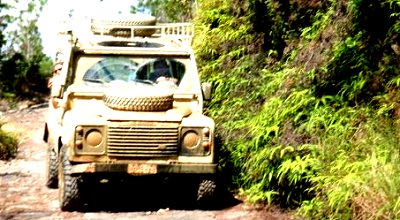5 Essential Land Rover Expedition Modifications
An expedition Land Rover needn't be an overly expensive beast. The stock version of the Defender performs very well in harsh environments, but a few select additions can turn the well designed Defender into a more reliable and useful vehicle. You could go all the way with modifications to make sure there is a piece of equipment added for every eventuality, but if you're on a budget (as most of us are), what are the most important additions to your Land Rover to get the most from your expedition?
Snorkel
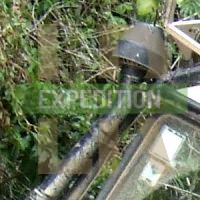
The very essence of an expedition in a Land Rover requires you to go off road. The most apparant differences are the unsealed roads and a great presence of standing (or flowing) water. The snorkel might conjure images of wading deep in bonnet high water, for which it certainly is the only way to do that without flooding the engine air intake, but it also helps reduce ingesting the dust kicked up from the road surface.
Following a vehicle on a dirt road will often leave you in a cloud of dust, which will eventually clog the air filter and will harm performance. It'll either need a good clean or replacing. A snorkel literally raises the air intake above the height at which most dust is kicked up and reduces the amount that the engine sucks in, helping to prolong the life of your air filter. It is important to have a rain cover to prevent the ingress of water as the snorkel is a direct link to the inside of the engine, and any water is incompressible resulting in disasterous consquences in the cylinders.
Roof Rack
When preparing for an expedition, you'll probably realise that you start to run out of room inside the Land Rover before you've packed all of your equipment, - especially in a Station Wagon. So the absolute no-brainer is the addition of a roof rack to store the things which aren't going to mind getting wet. A welcome addition also would be a ladder unless you're a gymnast or don't mind clambering over un-chequered wings.
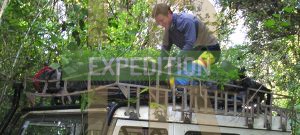
There are a variety of roof rack models, but the most useful for expedition purposes are 3/4 or full framed racks, which in effect create a basket on the roof. The official stated load capacity on the roof of a Land Rover is 75kg (equivalent or less than a grown man), as it makes a huge difference to the handling of the vehicle on corners. In practise, I have found this to be conservative, but only as long as you adjust your speed accordingly. I have driven with out 300kg on the roof, and whilst there were a few heart stopping moments off road, a Land Rover is more than capable of supporting this kind load.
It may be the case that you want to use the roof space to the max and install a roof tent for your luxurious needs, although it's a bit beyond the idea of 'expedition essentials'.
Steel Wheels
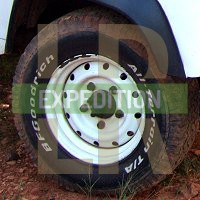 Most Land Rovers are fitted with steel wheels, but may have been changed to alloy wheels. The choice of wheel is important as steel is more malleable and absorbs shocks better than an alloy wheel which is more brittle. The upshot is that an alloy could shatter on hard and rough ground. Land Rover's own steel wheels come in the normal (below) and heavy duty Wolf (right) variety.
Most Land Rovers are fitted with steel wheels, but may have been changed to alloy wheels. The choice of wheel is important as steel is more malleable and absorbs shocks better than an alloy wheel which is more brittle. The upshot is that an alloy could shatter on hard and rough ground. Land Rover's own steel wheels come in the normal (below) and heavy duty Wolf (right) variety.
Alloy wheels hold the weight advantage over steel wheels, requiring less acceleration and braking force, causing less stress to steering and suspension bushes and other components. However, whether standard or heavy duty, steel wheels are a must when engaging in off road driving, particularly in rocky terrain.
Mud Tires
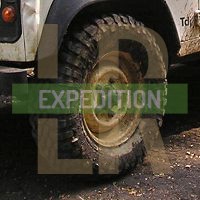
Supposing you're going in the mud, and since this is a Land Rover expedition we're talking about and you're going somewhere where it rains, then these are a must have. It's no surprise that the only things that connect the vehicle to the ground are quite important. Good mud tires can make the world of difference to handling off road.
I would always choose tires for the worst terrain likely to be encountered. All terrain tires are a hybrid, but are average on road, and average off road. Personally, I would get tires that are very good off road, where they make the most decisive difference. Seeing as Land Rovers don't go so fast on road (and shouldn't be driven so), I wouldn't be too worried about the on road handling. I have found Pirelli Scorpion tires to be very good. Don't expect decent tires to come cheap, although their investment will very likely get you out of the sh*t in the future....
Steering Guard
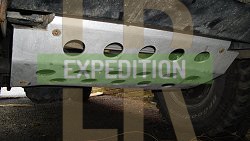
The most sensitive parts of a Land Rover coincidentally happen to be placed the closest to any possible collision. A smack on the steering rod can render your vehicle flailing and fish tailing as its wheels point in different directions. Hitting your steering parts on rocks and other hard objects is a very real danger and has a big impact (excuse the pun). Bending a steering bar is hardly a drama; a solid tug to straighten it out will bring the tracking back to a more than adequate state when off road. A steering guard will help limit the bending or protect the steering completely from any deformation, which although can be fixed, creates an everlasting weakness.
NB. You may be wondering why a winch hasn't made the list. In my mind, I believe the above equipment to be more useful and elemental than a winch. Use of a ladder and a jack will help you to understand the principles of getting stuck, which will in turn help your driving style. In this respect I don't deem a winch to be 'essential', but it clearly has its uses.
